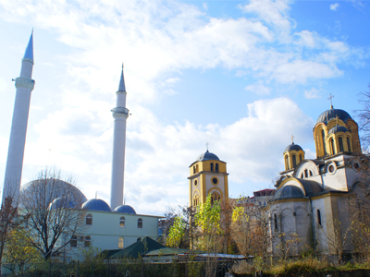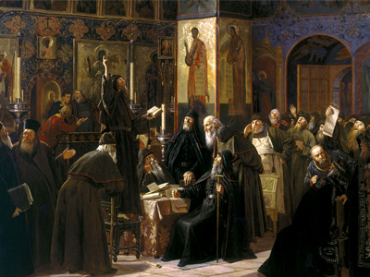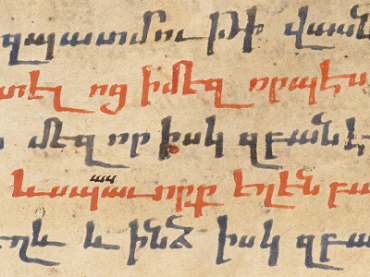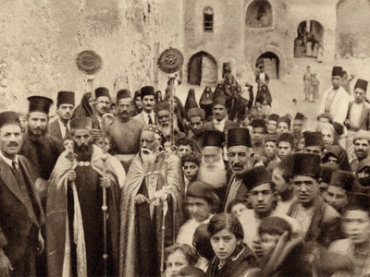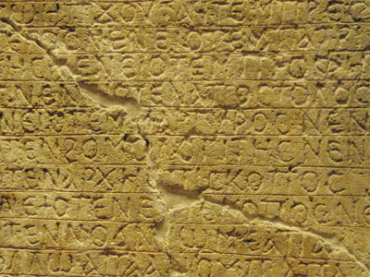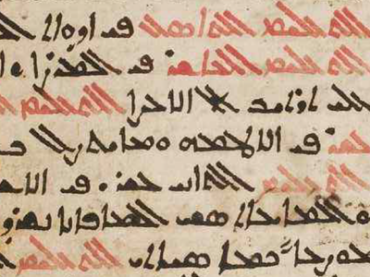Syriac and Eastern Christianity
On This Day (September)
The Armenian Church Synaxarion (Yaysmawurkʿ)
Edited and Translated by Edward G Mathews Jr
Series: The Armenian Church Synaxarion 9
ISBN: 978-1-4632-4577-1
The Armenian Church Synaxarion is a collection of saints’ lives according to the day of the year on which each saint is celebrated. Part of the great and varied Armenian liturgical tradition from the turn of the first millennium, the first Armenian Church Synaxarion represented the logical culmination of a long and steady development of what is today called the cult of the saints. This volume, the first Armenian-English edition, is the ninth of a twelve-volume series—one for each month of the year—and is ideal for personal devotional use or as a valuable resource for anyone interested in saints.
$79.00 $63.20
Hugoye - Journal of Syriac Studies (volume 24)
2021
General Editor George Anton Kiraz
Series: Hugoye: Journal of Syriac Studies 24
ISBN: 978-1-4632-4581-8
Widely regarded as a premier journal dedicated to the study of Syriac, Hugoye: Journal of Syriac Studies was established in 1998 as a venue devoted exclusively to the discipline. An organ of Beth Mardutho, the Syriac Institute, the journal appears semi-annually and will be printed in annual editions. A peer-reviewed journal, Hugoye is a respected academic source for up-to-date information about the state of Syriac studies and for discovering what is going on in the field. Contributors include some of the most respected names in the world of Syriac today.
$75.00 $60.00
Selected Studies in Ancient Language Lexicography, Linguistics and Translation
ISBN: 978-1-4632-4585-6
A collection of articles presented at the International Syriac Language Project (ISLP) meetings between 2017 and 2020, on the theme of lexicography, translation and text-critical matters across a range of ancient languages.
$114.95
The Collection of Wardā
A Contextual and Christological Analysis
By Dahlia Khay Azeez, Dahlia Khay Azeez, Dahlia Khay Azeez, Dahlia Khay Azeez, Dahlia Khay Azeez & Dahlia Khay Azeez
Series: Gorgias Eastern Christian Studies 70
ISBN: 978-1-4632-4589-4
A study of twenty hymns from the collection of liturgical hymns known as the “Book of Wardā” – hymns attributed to a poet from the thirteenth century named Gīwargīs Wardā. The hymns of this book are chanted during the liturgy of the Assyrian Church of the East, Ancient Church of the East, and the Chaldean Church. A critical edition and translation is given for each poem, and the book includes a commentary on the themes expressed in the poems.
$114.95
Key Word in Context Concordance to the Syriac New Testament (vol 1)
Edited by George Anton Kiraz
Series: Surath Kthob 36
ISBN: 978-1-4632-4591-7
The first comprehensive keyword-in-context concordance to the Syriac New Testament in six large volumes. It unlocks the treasure trove of the Syriac New Testament Peshitta readings and helps the reader to dive into the heart of this ancient Christian text, exploring its linguistic nuances, contextual meanings, and spiritual depths.
$235.00 $188.00
Key Word in Context Concordance to the Syriac New Testament (vol 2)
Edited by George Anton Kiraz
Series: Surath Kthob 36
ISBN: 978-1-4632-4593-1
The first comprehensive keyword-in-context concordance to the Syriac New Testament in six large volumes. It unlocks the treasure trove of the Syriac New Testament Peshitta readings and helps the reader to dive into the heart of this ancient Christian text, exploring its linguistic nuances, contextual meanings, and spiritual depths.
$267.00 $213.60
Key Word in Context Concordance to the Syriac New Testament (vol 3)
Edited by George Anton Kiraz
Series: Surath Kthob 36
ISBN: 978-1-4632-4595-5
The first comprehensive keyword-in-context concordance to the Syriac New Testament in six large volumes. It unlocks the treasure trove of the Syriac New Testament Peshitta readings and helps the reader to dive into the heart of this ancient Christian text, exploring its linguistic nuances, contextual meanings, and spiritual depths.
$274.00 $219.20
Key Word in Context Concordance to the Syriac New Testament (vol 4)
Edited by George Anton Kiraz
Series: Surath Kthob 36
ISBN: 978-1-4632-4597-9
The first comprehensive keyword-in-context concordance to the Syriac New Testament in six large volumes. It unlocks the treasure trove of the Syriac New Testament Peshitta readings and helps the reader to dive into the heart of this ancient Christian text, exploring its linguistic nuances, contextual meanings, and spiritual depths.
$235.00 $188.00
Key Word in Context Concordance to the Syriac New Testament (vol 5)
Edited by George Anton Kiraz
Series: Surath Kthob 36
ISBN: 978-1-4632-4599-3
The first comprehensive keyword-in-context concordance to the Syriac New Testament in six large volumes. It unlocks the treasure trove of the Syriac New Testament Peshitta readings and helps the reader to dive into the heart of this ancient Christian text, exploring its linguistic nuances, contextual meanings, and spiritual depths.
$167.00 $133.60
Key Word in Context Concordance to the Syriac New Testament (vol 6)
Edited by George Anton Kiraz
Series: Surath Kthob 36
ISBN: 978-1-4632-4601-3
The first comprehensive keyword-in-context concordance to the Syriac New Testament in six large volumes. It unlocks the treasure trove of the Syriac New Testament Peshitta readings and helps the reader to dive into the heart of this ancient Christian text, exploring its linguistic nuances, contextual meanings, and spiritual depths.
$235.00 $188.00
Lexical Aids to the Syriac New Testament (Third Expanded Edition)
Edited by George Anton Kiraz & Timothy A. Lee
Series: Gorgias Handbooks 61
ISBN: 978-1-4632-4603-7
Lexical Aids to the Syriac New Testament provides an essential tool to students of Syriac. A frequency-based glossary guides the student through the text of the Syriac New Testament’s most significant terms. In addition, verbal paradigms demystify the language’s structure, fostering a deeper understanding.
$58.00 $46.40
The Syriac Peshiṭta New Testament (Reader's Edition)
Edited by Timothy A. Lee
Series: Gorgias Handbooks 62
ISBN: 978-1-4632-4605-1
This is the first Syriac reader for the New Testament. It guides the reader through the Syriac New Testament Peshitta, glossing the uncommon words and parsing difficult word forms.
$52.00
The Syriac Peshiṭta Gospels (Reader's Edition)
Edited by Timothy A. Lee & Timothy A. Lee
Series: Gorgias Handbooks 63
ISBN: 978-1-4632-4607-5
This a Syriac reader for the Gospels. It guides the reader through the Syriac Peshitta Gospels, glossing the uncommon words and parsing difficult word forms.
$48.00
Water the Willow Tree (Arabic Edition)
Memoirs of a Bethlehem Boyhood
Series: Gorgias Handbooks 65
ISBN: 978-1-4632-4611-2
An Arabic translation of George A. Kiraz's engaging first memoir. The story of a young Palestinian boy growing up in Bethlehem, fascinated with understanding his Syriac roots even as he drew steadily nearer to the day when he would inevitably be transplanted to the United States.
$48.00 $38.40
Key Word in Context Concordance to the Syriac New Testament 6 vols. - Bundle
ISBN: 000-0-2023-0001-X
The first comprehensive keyword-in-context concordance to the Syriac New Testament in six large volumes. It unlocks the treasure trove of the Syriac New Testament Peshitta readings and helps the reader to dive into the heart of this ancient Christian text, exploring its linguistic nuances, contextual meanings, and spiritual depths.
$847.80
Journal of the Canadian Society for Syriac Studies 23
Edited by Amir Harrak
ISBN: 978-1-4632-4619-8
A refereed journal published annually by the Canadian Society for Syriac Studies.
$75.00
Le combat spirituel chez Isaac de Ninive
By Paul Matar
Series: Gorgias Eastern Christian Studies 68
ISBN: 978-1-4632-4623-5
Pourquoi Isaac de Ninive ? Et pourquoi le thème du combat chez lui aujourd’hui ? Nous avons essayé de donner par la figure d’Isaac un remède efficace aux problèmes de notre monde qui est assujetti aux nouvelles technologies, au bruit, à la consommation, à la guerre, à l'égoïsme, etc. Remède composé d’armes avec lesquelles nous pouvons construire et ne jamais détruire, surtout avec l’arme de la miséricorde. À travers ce livre, nous avons noté que les problèmes de l’homme du troisième millénaire ne sont pas seulement sociaux, économiques, politiques et psychologiques, mais aussi spirituels.
$114.95 $91.96
Orthodox Choreographies
Boundaries, Borders and Materiality in Jerusalem's Old City
Series: Gorgias Eastern Christian Studies 69
ISBN: 978-1-4632-4625-9
The book offers a comprehensive anthropological study of lived Christianity in Jerusalem’s Old City, with a special focus on the Church of the Holy Sepulchre or the Church of the Anastasis. Based on in-depth ethnographic fieldwork, the study explores the experiences of the Rum Orthodox community, examining their internal dynamics and relationships with other Christian groups. Within the Church of the Anastasis, complex interplays emerge, as fragile legal agreements intermingle with ethnic and theological considerations, resulting in a complex reality of shared spaces and coexistence. A materialist lens is employed to study these dynamics, suggesting that the material aspects of religious practices play a crucial role in shaping borders and influencing perceptions of similarities and differences across them. Outside the Church's confines, in the Old City of Jerusalem, lay Christians, especially the local Palestinian Orthodox, engage in 'border-crossing practices', which often deviate from the Orthodox Church's approved practice. These practices reflect the flexible strategies local Christians adopt in their everyday lives in Israel, challenging established norms and boundaries. By capturing these dynamics, the book provides valuable insights into shared sacred spaces and offers a significant contribution to debates in the anthropology of Christianity and its material culture.
$114.95 $91.96
On This Day (October)
The Armenian Church Synaxarion (Yaysmawurkʿ)
Edited and Translated by Edward G Mathews Jr
Series: The Armenian Church Synaxarion 10
ISBN: 978-1-4632-4768-3
The Armenian Church Synaxarion is a collection of saints’ lives according to the day of the year on which each saint is celebrated. Part of the great and varied Armenian liturgical tradition from the turn of the first millennium, the first Armenian Church Synaxarion represented the logical culmination of a long and steady development of what is today called the cult of the saints. This volume, the first Armenian-English edition, is the tenth of a twelve-volume series—one for each month of the year—and is ideal for personal devotional use or as a valuable resource for anyone interested in saints.
$79.00
Filter by
Filter by price
Filter by manufacturer

